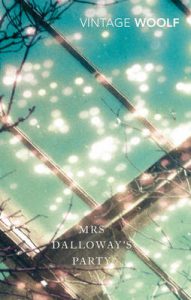 It’s time for another check-in with the #Woolfalong (see my previous posts on Mrs Dalloway and The Voyage Out). The May/June theme is perhaps a little more off the beaten track: Virginia Woolf’s short stories. I’ve been trying to use my #Woolfalong selections to build a picture of Woolf’s work, piece by piece; so it seemed logical to choose a collection linked to a book I’d already read.
It’s time for another check-in with the #Woolfalong (see my previous posts on Mrs Dalloway and The Voyage Out). The May/June theme is perhaps a little more off the beaten track: Virginia Woolf’s short stories. I’ve been trying to use my #Woolfalong selections to build a picture of Woolf’s work, piece by piece; so it seemed logical to choose a collection linked to a book I’d already read.
Mrs Dalloway’s Party is a sequence of seven stories put together by Stella McNichol after she became aware of them while working on the manuscripts of Mrs Dalloway. The opening two fall chronologically at or before the start of the novel (the first story, ‘Mrs Dalloway in Bond Street’, was originally meant to be Chapter One of the novel); the remaining five focus on individual guests at the party that closes Mrs Dalloway.
I’m drawn to a musical comparison here. Reading Mrs Dalloway’s Party was like listening to the offcuts of a familiar album: the stories were of a piece with the main work, but not part of it – sometimes disconcertingly so. There are elements of ‘Mrs Dalloway in Bond Street’ that I recognise from their later context, such as a mention of Mrs Foxcroft – so powerful to me in the novel; but not nearly so much the way it’s treated in the story.
I fared better with the wholly unfamiliar material of the later stories. It’s not quite the intoxicating tide of consciousness that I found in Mrs Dalloway; but there is still a sense of the interior world as a three-dimensional space, and the significance (or otherwise) of the social occasion to the individual. Here, for example, are two characters who have been introduced and begun to converse in the story ‘Together and Apart’:
Their eyes met; collided rather, for each felt that behind the eyes the secluded being, who sits in darkness while his shallow agile companion does all the tumbling and beckoning, and keeps the show going, suddenly stood erect; flung off his cloak; confronted the other. It was alarming; it was terrific. They were elderly and burnished into a glowing smoothness, so that Roderick Serle would go, perhaps to a dozen parties in a season, and feel nothing out of the common, or only sentimental regrets, and the desire for pretty images—like this of the flowering cherry tree—and all the time there stagnated in him unstirred a sort of superiority to his company, a sense of untapped resources, which sent him back home dissatisfied with life, with himself, yawning, empty, capricious. But now, quite suddenly, like a white bolt in a mist (but this image forged itself with the inevitability of lightning and loomed up), there it had happened; the old ecstasy of life; its invincible assault; for it was unpleasant, at the same time that it rejoiced and rejuvenated and filled the veins and nerves with threads of ice and fire; it was terrifying. “Canterbury twenty years ago,” said Miss Anning, as one lays a shade over an intense light, or covers some burning peach with a green leaf, for it is too strong, too ripe, too full.
This is a long quotation, but I think you need the length to appreciate the full effect: the familiar torrent of words, within which apparently mundane small talk has stirred a deep, primal sense of being alive (literature can also do that to a reader; reading Mrs Dalloway did it to me). Miss Anning’s distancing comment at the end tries to push this feeling away, but of course it will remain, latent, ready to emerge again if given the chance. This is how close Woolf brings us to her characters: into the very fabric of perception.
Book details (Foyles affiliate link)
Mrs Dalloway’s Party (1973) by Virginia Woolf, Vintage Classics paperback
Mrs Dalloway (1925) by Virginia Woolf, Vintage Classics paperback
21st June 2016 at 3:09 pm
I enjoyed this collection too. I enjoyed that interior world that we find in those later stories.
21st June 2016 at 6:21 pm
Sounds very interesting. I have read Mrs. Dalloway recently and loved the read. This would would be a familiar and nice read for me
22nd June 2016 at 8:22 pm
I loved Mrs Dalloway, but this seems an odd and slightly artificial collection. I’ll likely read it once I’ve read a fair bit more Woolf, but probably not sooner.
Gorgeous cover though.
8th July 2016 at 8:37 pm
To be honest, Max, one of the reasons I read this was that it was so short! You’re right about it being artificial: it was assembled by McNichol after the fact. But I think Wool only published one story collection in her lifetime, so any of the others will probably have that put-together feeling.